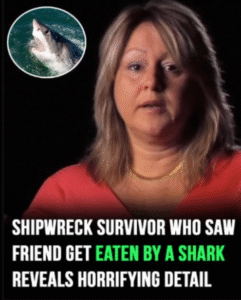🏊♀️ The Decision to Swim
When dawn broke, Tamara made a bold decision: they needed to swim to shore. Christy, the only one who couldn’t swim, was reassured that salt water would help her float. Tamara led the group into the ocean, hoping that movement would increase their chances of rescue.
But the ocean is not a passive witness. It watches. It waits.
About an hour into the swim, Tamara heard Christy scream. At first, she thought her friend was drowning. But then she saw it—the unmistakable sign of a shark attack. Christy was thrown upward out of the water, then dragged back down. “It was just like in the movie Jaws,” Tamara said. “She went straight up and straight back into the water. And I knew she’d been hit by a shark”.
🦈 The Horror Unfolds
Randy, unaware of the shark, thought Christy was simply struggling. He swam toward her, calling her name. But Tamara saw the truth. Christy was thrashing, screaming, begging: “Come and get me now!” Then she went up again—and down. The last time Tamara saw her, Christy was face down, pale, and lifeless. “I knew she was dead. She was completely white. I knew she’d lost all her blood”.
Tamara made a gut-wrenching decision: she would not go back. She couldn’t. The shark was still there. She swam forward, alone, haunted by the image of her friend’s final moments.
🧠 Thinking Like a Fish
Soon after, Tamara felt something bump against her. A shark. Panic surged through her body. But instead of succumbing to fear, she made a radical mental shift. “I just had a split-second vision of Christy and me saying, ‘That’s not how I want to go. There is no way I can die like this,’” she said.
She began to think like a fish. She told herself she belonged in the water just as much as the shark did. It was a psychological survival mechanism—one that helped her stay calm and keep swimming.
🌊 Five Hours of Terror
Tamara swam for five hours. At one point, she saw sharks ahead in a feeding frenzy. She lost sight of Randy and Daniel. A rip tide pulled her away from the shore. But she remembered a survival tip: swim sideways to escape the current. Eventually, she broke free and reached land.
She was alive. But the trauma would follow her forever.
🧬 Trauma, Memory, and the Human Mind
Tamara’s story isn’t just about sharks—it’s about the human psyche under extreme duress. Her ability to compartmentalize fear, to reframe her relationship with the ocean, and to make split-second decisions speaks to the resilience of the mind.
Survivors of traumatic events often describe a surreal clarity—a hyper-awareness that kicks in when the body is in danger. Tamara’s recollection of Christy’s death is vivid, cinematic, and emotionally charged. It’s not just memory; it’s imprint.
📺 Why This Story Resonates Now
The viral resurgence of Tamara’s account has struck a chord in 2025. In an age of curated social media and sanitized narratives, her raw honesty feels like a jolt of reality. It reminds us that nature is indifferent, that survival is messy, and that courage often looks like quiet determination.
Her story also challenges the glamorization of shark attacks in pop culture. This wasn’t Shark Week entertainment—it was a young woman watching her friend die in agony, knowing she might be next.
🧭 Final Reflections
Tamara Ennis survived the unthinkable. Her story is a testament to instinct, grit, and the will to live. But it’s also a haunting reminder of how fragile life can be—how quickly a sunny day on the water can turn into a nightmare.
The horrifying detail she recalls—the way Christy was lifted and dragged, the color draining from her body, the silence that followed—is etched into her soul. And now, through her words, it’s etched into ours.



